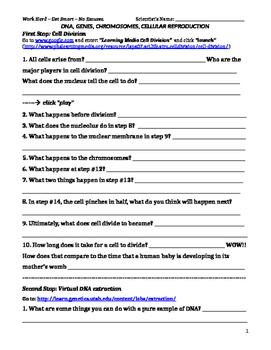DNA, Genes, Chromosomes, Cellular Reproduction Webquest
- Word Document File
- Webquests
Description
**Distance Learning and Remote Learning Appropriate
In this self-directed and interactive webquest, students explore the world of DNA, Genes, Chromosomes, and Cellular Reproduction. the first stop guides students through the basics and results of cell division. Ion the second stop, students virtually extract DNA. In the next stop, they compare and contrast mitosis and meiosis. In the fourth stop, they explore galleries of real microscopic footage of different types of cell division, fertilization and development. The next activity takes them deeper into mitosis and meiosis through engaging interactives. Next, students explore how cellular reproduction relates to genetics in an interactive lesson with many diagrams, interactives, examples and more. Students finish the webquest in a final DNA base pairing challenge. The webquest is engaging, informational, rigorous, exciting, and real-world meaningful and relevant. As a follow up, the webquest includes a homework (or exit ticket) essay assignment requiring students to synthesize and analyze what they have learned about cell reproduction, genes, DNA, chromosomes, inheritance, and genetic variation. They are to think about the following questions: What are the different ways cells reproduce? Which type of reproduction leads to more genetic variation? Where are DNA and chromosomes located within the cell? What is the difference between mitosis and meiosis? How are genes passed along from parents to offspring? This activity is engaging and exciting, and encourages students to be self-directed! It is aligned to 7th-grade science essential standards.





